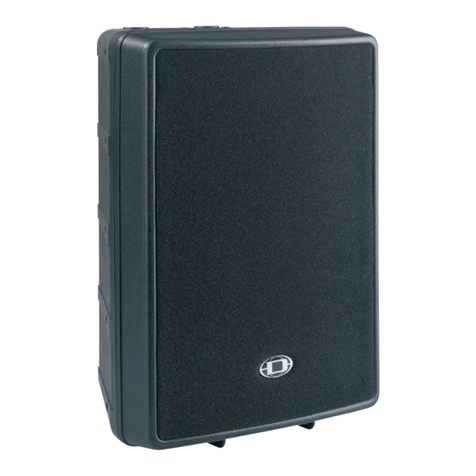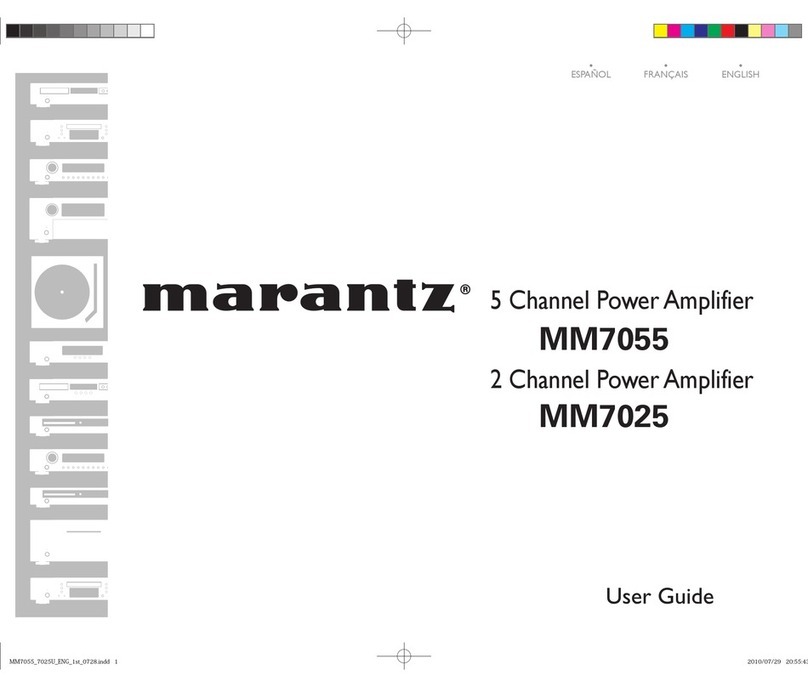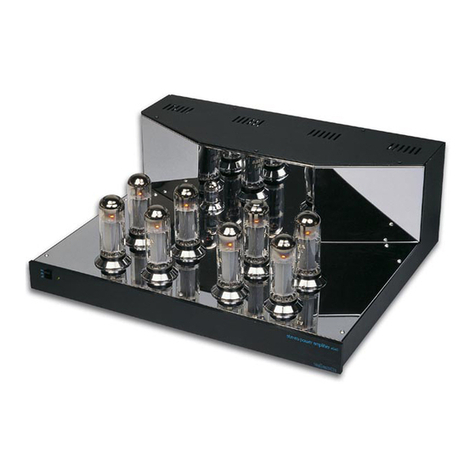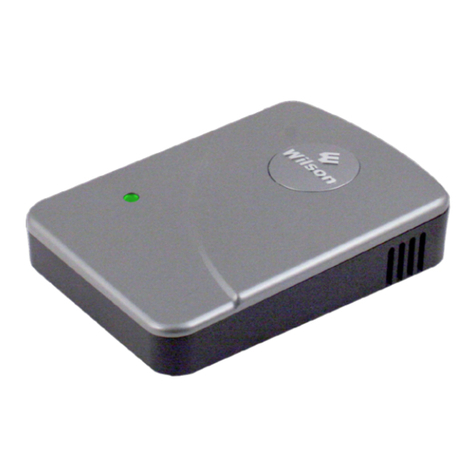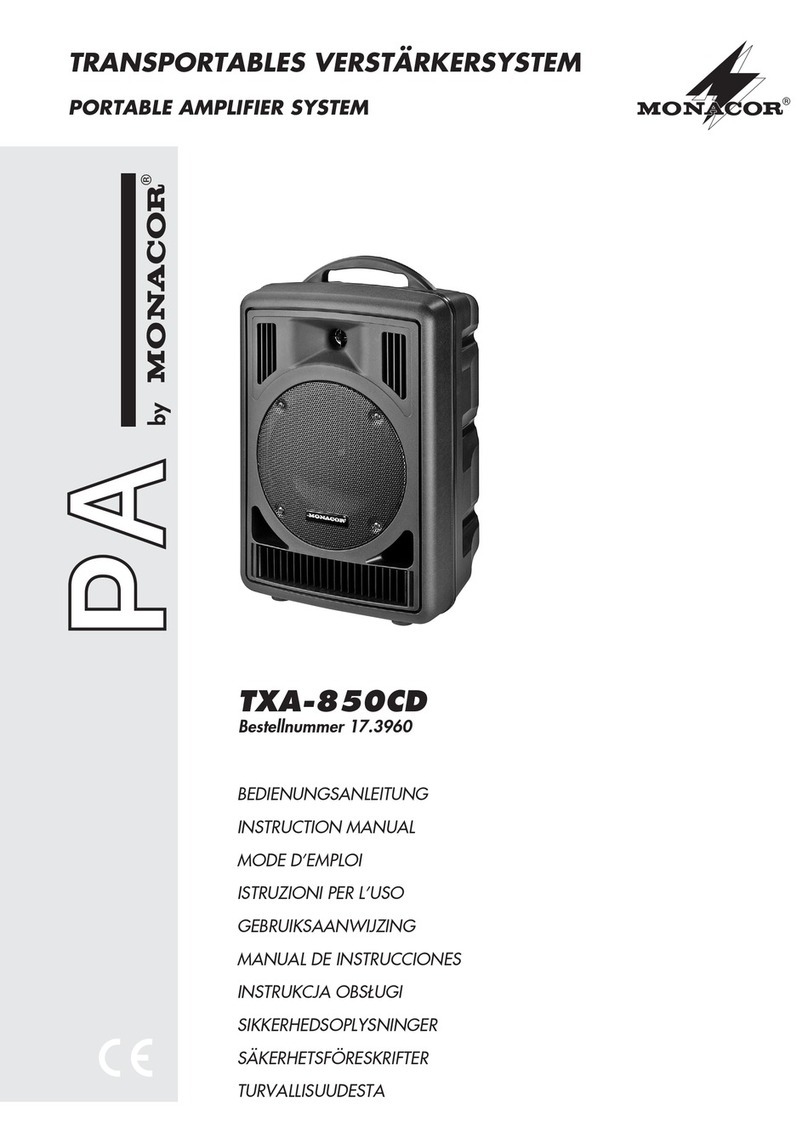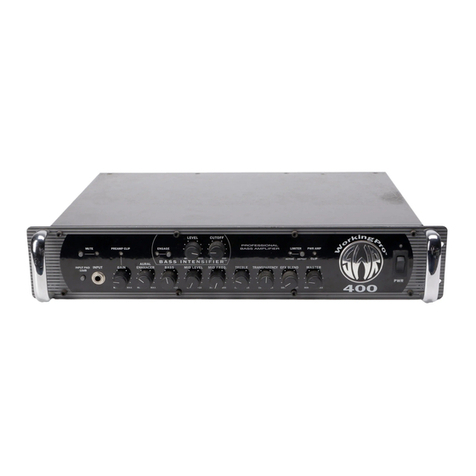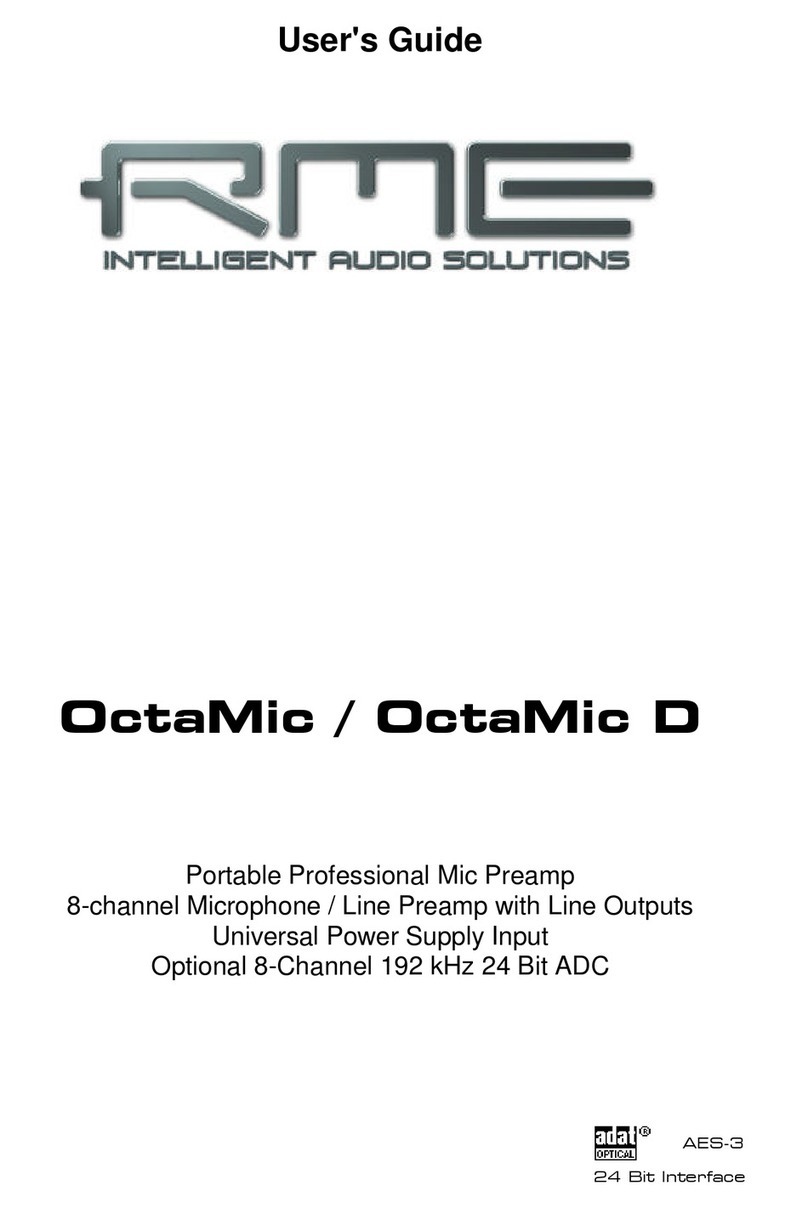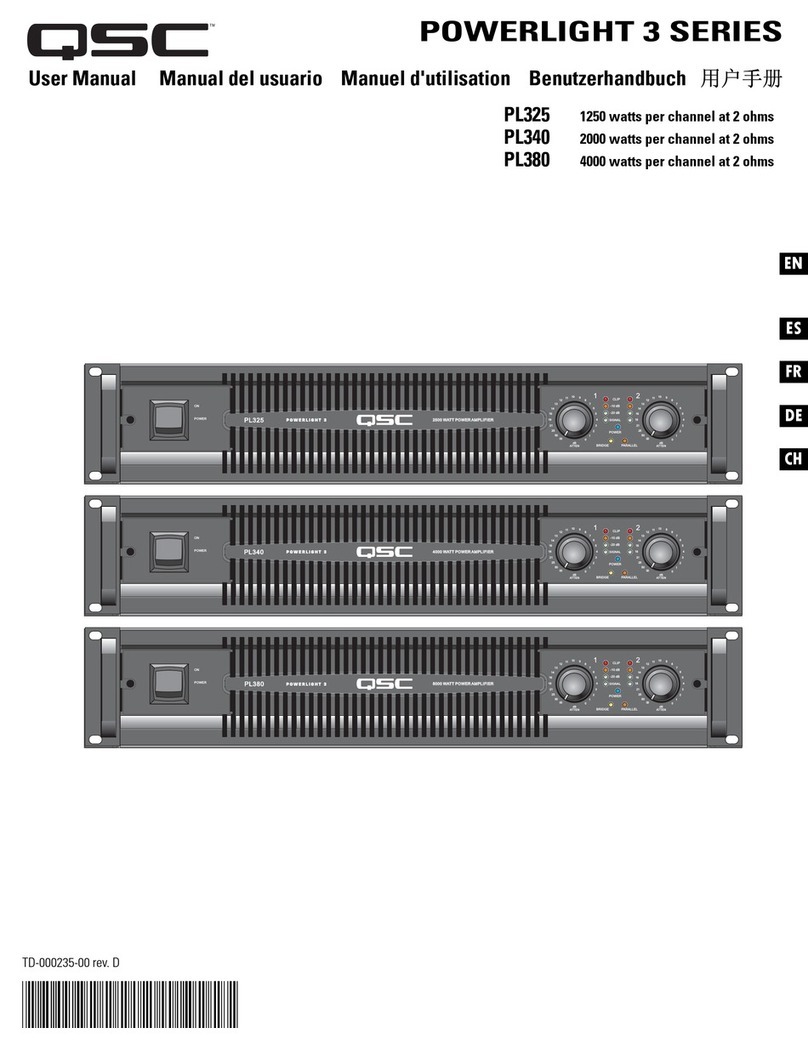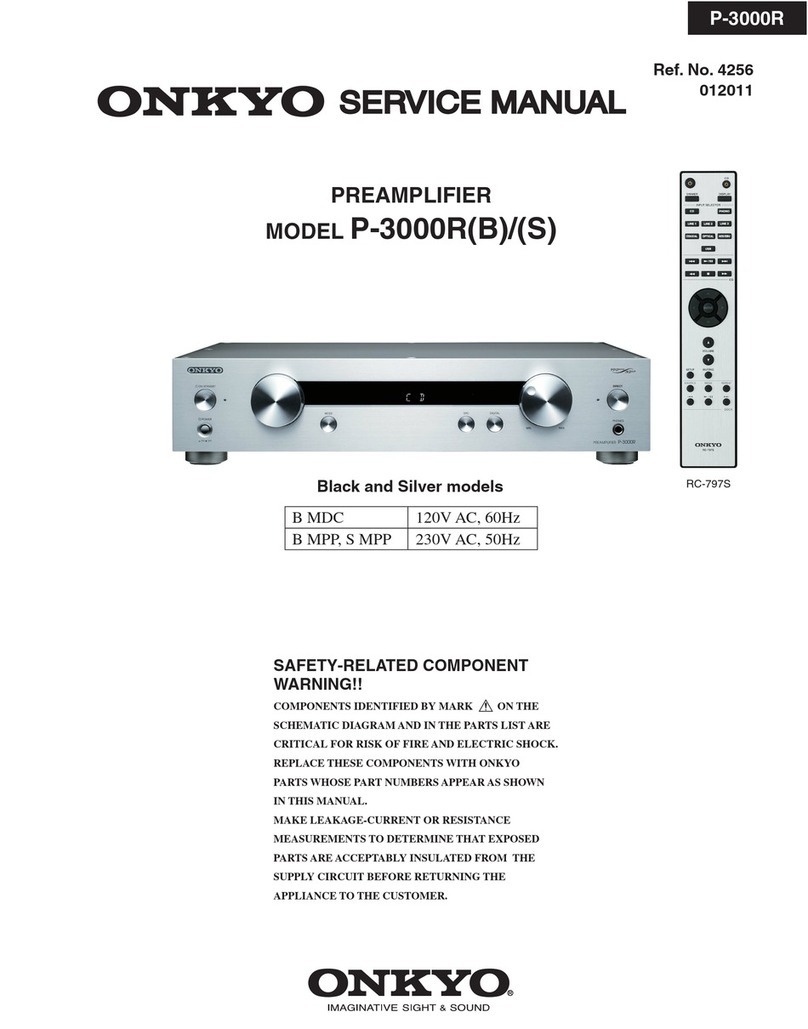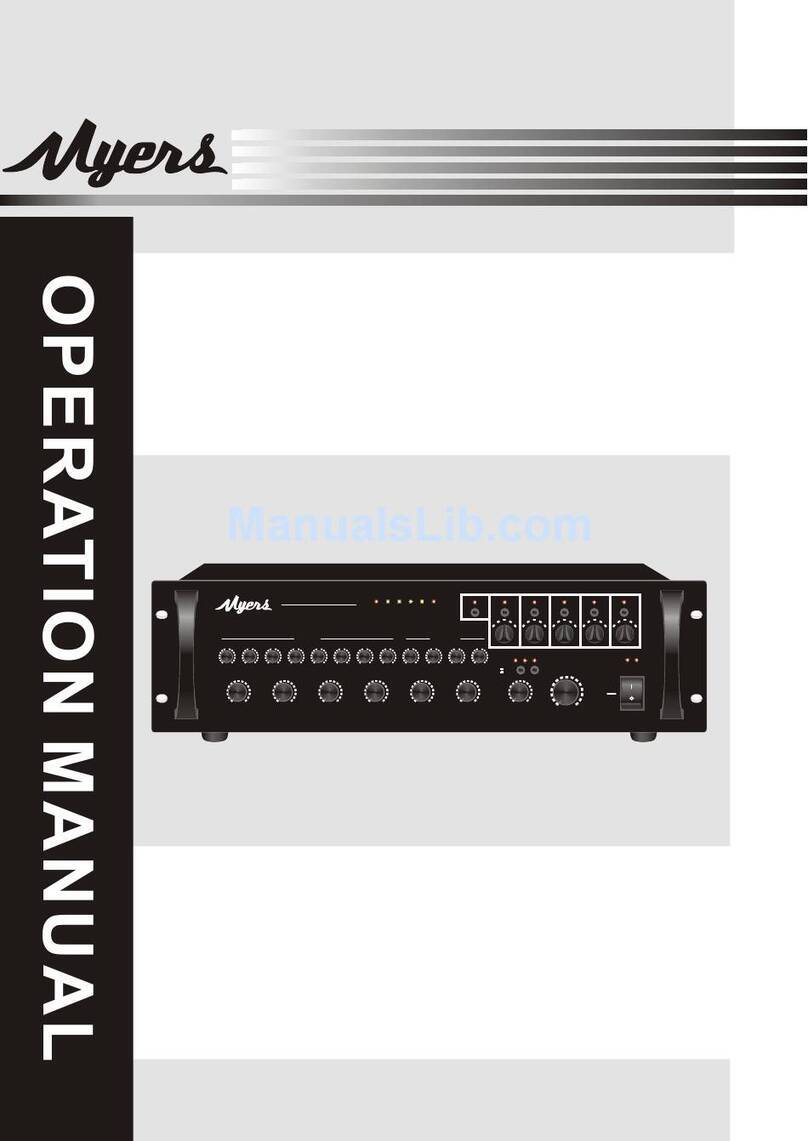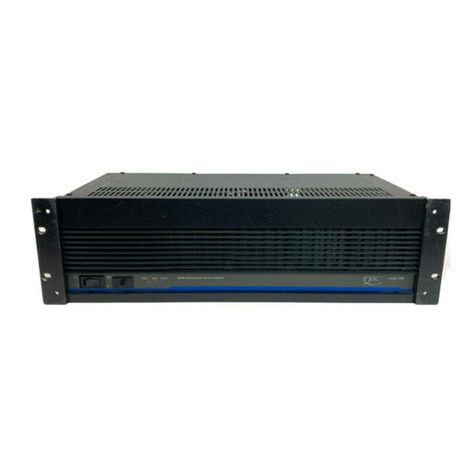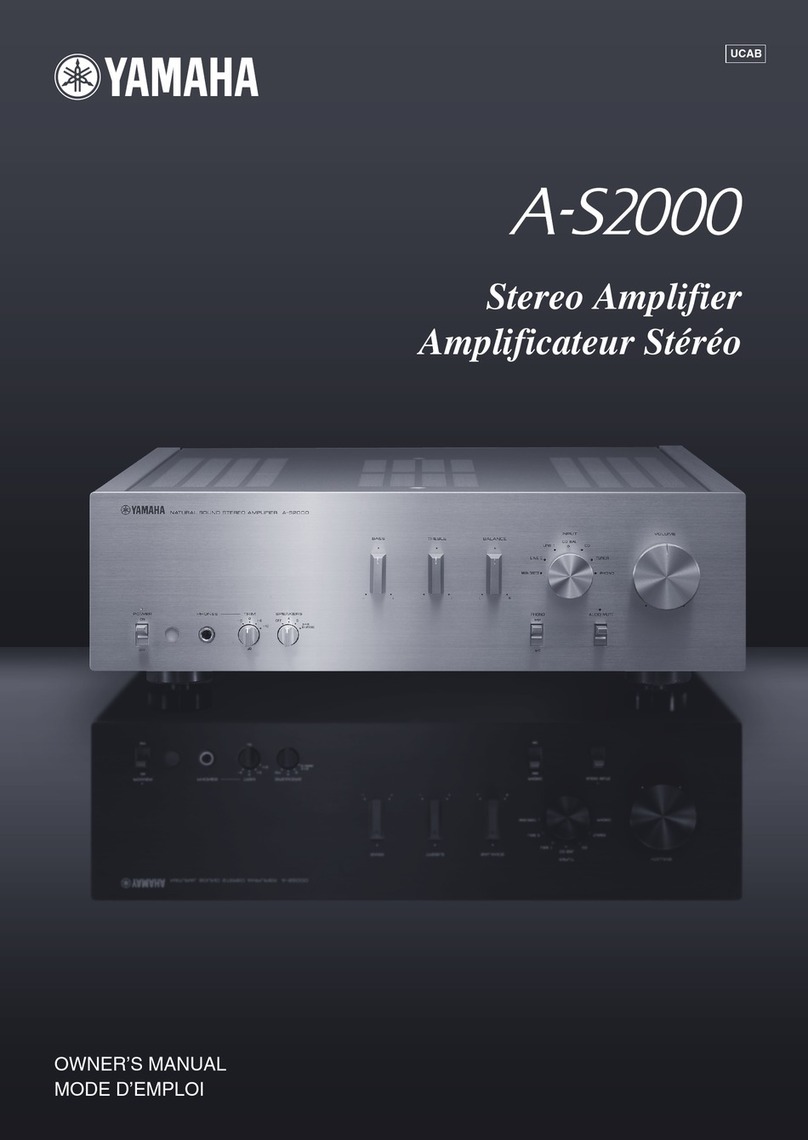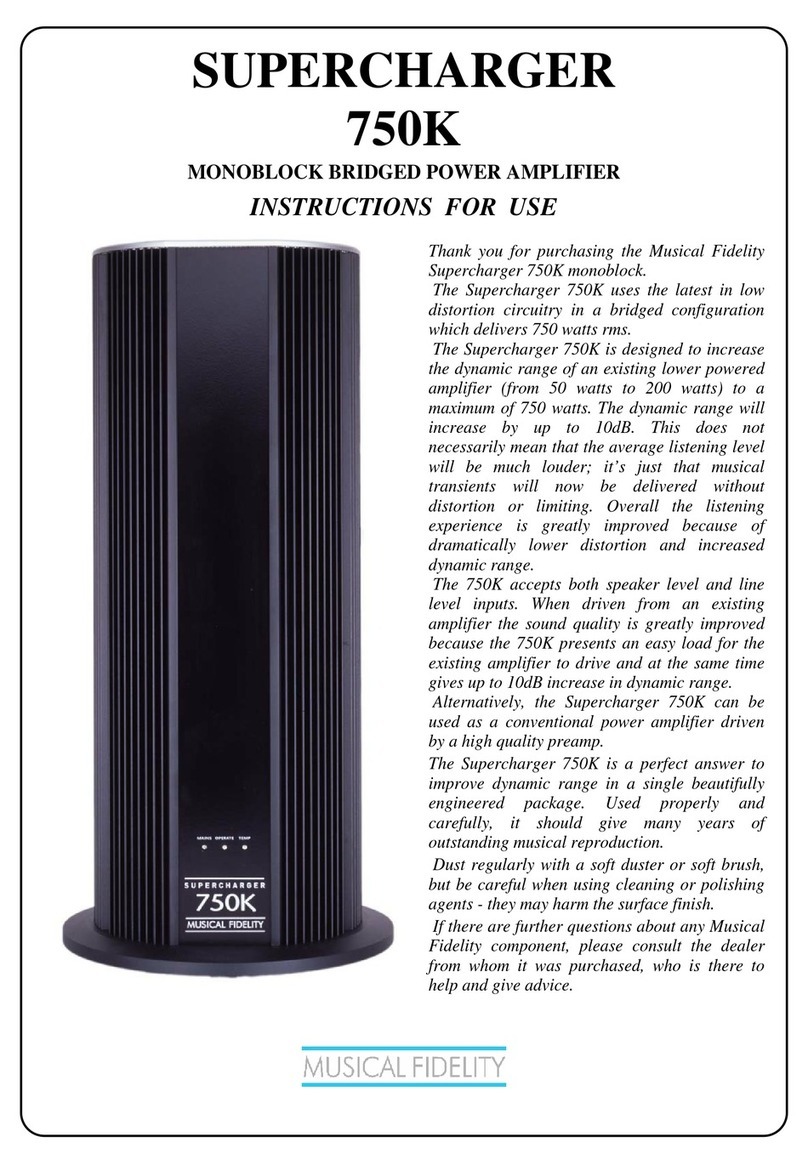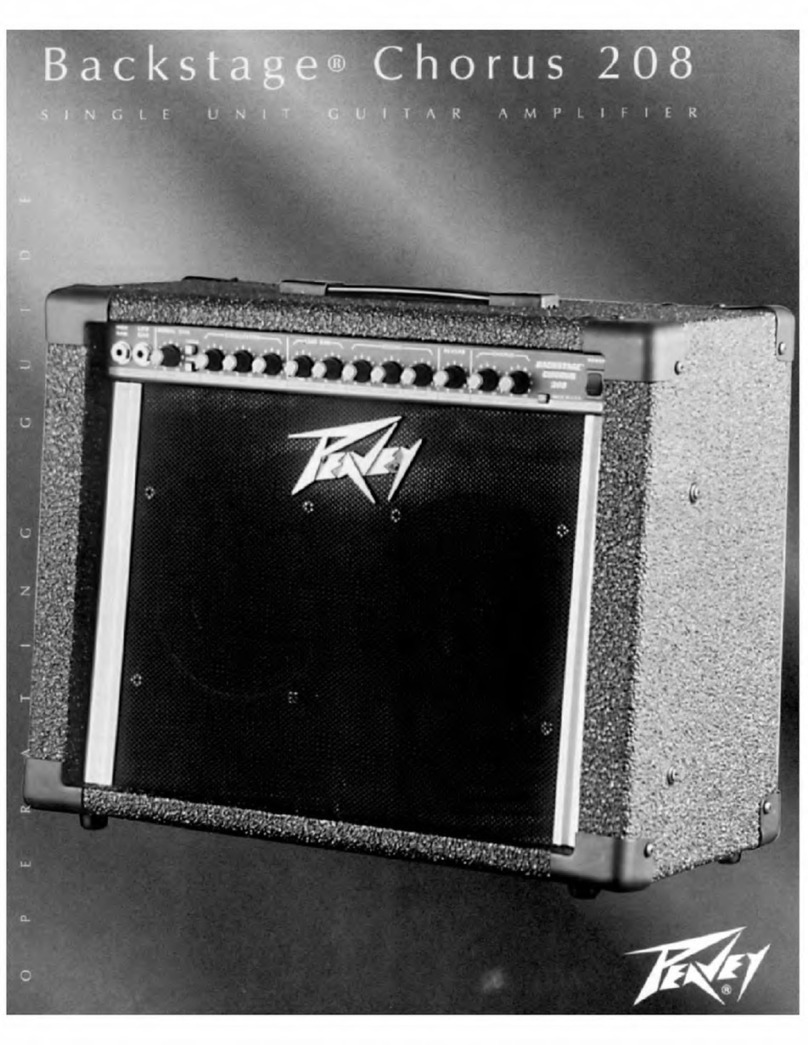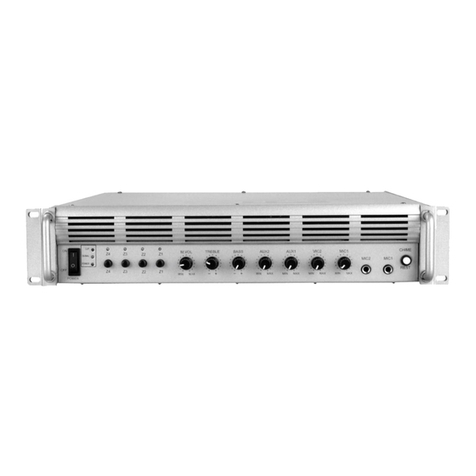General Instrument STARLINE MB-750D-H User manual

Dual-Output Amplifier
Model MB-750D-H
Model MB-750D-H/40
Installation Manual
ASSEMBLED IN MEXICO
General Instrument Corporation
GI Communications Division
Hatboro, Pa. 19040
20 dB
FWD/
RET
X0-36
20A
JXP
FWD
IN
FORWARD
EQUALIZER
JXP
JXP
JXP
FWD
INTR
FWD
OUT
FWD
OUT
MAN
ACB
OFF
L
H
X0-36
MB-750D-H
20 dB
PORT
2
20 dB
PORT3&4
RET
IN
JXP
X0-36
SPLIT
JXP
RET
OUT
AUTOMATIC CONTROL
BOARD
RETURN
EQUALIZER
SEE- *
RESPONSE
CORRECTION
MDR
EQ- *
IN
3
XO-36
4
DUAL HYBRID
POWER DOUBLING
MINI-BRIDGER
2
General Instrument
GI
EQUALIZER
MDR-750/10
C80
C81
C82
SEE-* EQUAL.
FORWARD CABLE
General Instrument Corporation
Hatboro, Pa. 19040
POWER SUPPLY
DC VOLTAGE
ADJUST
ASSEMBLED IN MEXICO
REGULATED DC VOLTAGE
DC (-) DC (+)POWER
GROUND
FUSE
VOLTS (RMS)
MAY BE PRESENT UNDER COVER
VOLTAGES IN EXCESS OF 150 VOLTS
CAUTION
MPPS AC
AC
ARRESTOR
SURGE
Jerrold Communications
AC LINE
VOLTAGE
GI General Instrument
Jerrold

Copyright © 1995 by General Instrument Corporation.
All rights reserved.
No part of this publication may be reproduced in any form or by anymeans or used to make any derivative work (such as translation,
transformation or adaptation) without written permission from General Instrument.
General Instrument reserves the right to revise this publication and to make changes in content from time to time without obligation on the part of
General Instrument to provide notification of such revision or change.
General Instrument provides this guide without warranty of any kind, either implied or expressed, including, but not limited, to the implied warranties
of merchantability and fitness for a particular purpose. General Instrument may make improvements or changes in the product(s) described in this
manual at any time.
Cableoptics and STARLINE are registered trademarks of General Instrument Corporation.

MB-750D-H and MB-750D-H/40 Mini-Bridger Installation Manual
Contents
Introduction .......................................................................................................................1
Using This Manual....................................................................................................................1
Related Documentation............................................................................................................1
If You Need Help.......................................................................................................................2
Calling for Repairs ....................................................................................................................2
Overview ............................................................................................................................3
Product Description ..................................................................................................................3
Optional Components and Accessories....................................................................................4
Assemblies and Modules..........................................................................................................5
Housing Model MB-HSG/60...............................................................................................5
Model MPPS Power Pack ..................................................................................................5
Forward Amplifier...............................................................................................................7
Models MBD-SPLT and MBD-DC......................................................................................8
Return Signal Path.............................................................................................................8
Forward Output Level Control............................................................................................9
Power Control Options.......................................................................................................9
Automatic Control Board....................................................................................................9
Preinstallation Procedures .............................................................................................11
Configuring the MB-750D-H*..................................................................................................11
Forward Equalizer, Model EQ-750-* ................................................................................11
Output Passives...............................................................................................................13
Power Control Options.....................................................................................................14
Automatic Control Board Option, Model MB-ACB/* .........................................................14
Two-Way Option ..............................................................................................................14
Bench Powering the MB-750S-H/40/E Amplifier..............................................................15
Installing DF1-SS/40 Diplex Filters...................................................................................15
Sweep Response and Gain Testing.................................................................................17
Manual Thermal Gain Control..........................................................................................18
Flatness............................................................................................................................18
Operational Gain..............................................................................................................19
Automatic Level Control...................................................................................................20

ii Contents
MB-750D-H and MB-750D-H/40 Mini-Bridger Installation Manual
Field Installation ..............................................................................................................21
Mechanical Installation...........................................................................................................21
Housing Connections.......................................................................................................21
Mounting the Housing......................................................................................................21
Power-up................................................................................................................................22
Balancing the Amplifier...........................................................................................................22
Manual Thermal Gain Control................................................................................................23
Automatic Level Control .........................................................................................................23
Closing the Housing ...............................................................................................................24
Specifications ..................................................................................................................25
Amplifier .................................................................................................................................25
Automatic Control Board, MB-ACB/∗.....................................................................................26
Return Amplifier Kit, RA-Kit/40L.............................................................................................26
Diplex Filters, DF1-SS/40 and DF1-SS..................................................................................26
List of Figures
Figure 1 MB-750D-H and MB-750D-H/40 Mini-Bridger block diagram ..................................4
Figure 2 Mini-Bridger amplifier module, showing location of accessories..............................5
Figure 3 Block diagram of MPPS power pack........................................................................6
Figure 4 MPPS Power pack ...................................................................................................7
Figure 5 Forward amplifier module.........................................................................................8
Figure 6 Tilt versus cable.....................................................................................................13
Figure 7 Model MBD-DC output directional coupler.............................................................13
Figure 8 Restoring impedance match, port 3.......................................................................15
Figure 9 Restoring impedance match, port 4.......................................................................16
Figure 10 Typical test equipment and connections..............................................................17
Figure 11 MDR-750/10 Board ..............................................................................................19
Figure 12 Effect of flatness controls.....................................................................................19
Figure 13 Pin connector .......................................................................................................21
Figure 11 MB-HSG/60 Housing............................................................................................22

MB-750D-H and MB-750D-H/40 Installation Manual
Section 1
Introduction
The General Instrument STARLINE®Mini-Bridgers, models MB-750D-H and MB-750D-H/40
are versatile amplifiers used in modern television distribution systems for amplification of
standard National Television Sytem Committee (NTSC) television carriers as well as
high-definition digital channels. The MB-750D-H and MB-750D-H/40 amplify conventional
signals carried in the bandpass between 50 MHz and 550 MHz as well as high-definition digital
television signals carried in the bandpass between 550 MHz and 750 MHz. These digital
carriers have their relative amplitude set at the headend and normally operate 10 dB below
standard NTSC television channels.
Using This Manual
This manual provides instructions for the following tasks necessary to install, configure, and
operate the MB-750D-H and MB-750D-H/40 mini-bridgers:
Section 1 Provides a brief review of the function of the product in a distribution system. Identifies the
information contained in this manual, lists related documentation, and gives the helpline
telephone number.
Section 2 Provides a detailed description of the various components used in the amplifier. It also
provides instructions on proper installation of all options and subassemblies.
Section 3 Describes methods of bench alignment, testing, and configuration of the unit prior to
installing it in the system.
Section 4 Describes the installation and field alignment procedures required to place the unit into
service.
Appendix A Lists the applicable specifications for the amplifier and options.
This installation manual assumes that all channels are standard NTSC analog channels. Refer
to catalog specifications or Appendix A, Specifications, in this document for further details
pertaining to signal levels of digital channels above 550 MHz.
The asterisk (*) indicates that there are several versions or model numbers, and the information
applies to all models. When the information applies to a specific model, the full model number is
given.
Related Documentation
This installation manual is complete and you should not require any additional documentation
to install, test or operate the MB-750D-H and MB-750D-H/40 mini-bridgers.

2Introduction
MB-750D-H and MB-750D-H/40 Installation Manual
If You Need Help
If you need assistance while working with the MB-750D-H or MB-750D-H/40, call the General
Instrument Technical Response Center at 1-800-537-7653. The Technical Response Center is
open 8:00 am to 6:00 pm Eastern Standard Time, Monday through Friday. When the Technical
Response Center is closed, emergency service only is available on a call-back basis.
When contacting the Technical Response Center from outside the United States, please use our
main switchboard number, 1-215-674-4800. After business hours, please use 1-215-581-9637.
Calling for Repairs
If repair is necessary, call the General Instrument Repair Facility at 1-800-642-0442 for a
Return for Service Authorization (RSA) number before sending the unit. The RSA number must
be prominently displayed on all equipment cartons. The Repair Facility is open 7:00 am to
4:00 pm Pacific Standard Time, Monday through Friday.
If calling from outside the United States, dial your appropriate international access code, then
dial 52-631-34000, to contact the Repair Facility.
When shipping equipment for repair, follow these steps:
Pack the unit securely.
Enclose a note describing the exact problem.
Enclose a copy of the invoice that verifies the warranty status.
Ship the unit PRE-PAID to the following address:
GI Communications
c/o Fritz Company
1451-1 Mariposa Industrial Drive
Nogales, AZ 85621
Attn: RSA #___________

MB-750D-H and MB-750D-H/40 Installation Manual
Section 2
Overview
Product Description
The model MB-750D-H and MB-750D-H/40 Mini-Bridgers are dual output, high gain,
three-stage hybrid amplifiers designed to drive both a limited cascade as well as a local
distribution system. These amplifiers provide 110-channel capability utilizing a forward
bandpass of 50 to 750 MHz and a return path of either 5 to 30 MHz for model MB-750D-H and
5 to 40 MHz for model MB-750D-H/40. The high gain feature — 35 dB operational — makes the
amplifiers suitable for drop-in replacement of trunk amplifiers that were originally spaced for
22 dB at 300 MHz. Use of the mini-bridgers eliminates the need for intermediate amplifiers
normally required to modify a “tree-and-branch” system into a “fiber-to-the-feeder” architecture.
The attenuation of coaxial cable as used in CATV systems changes with variations in
temperature. To assist in compensating for these changes, the MB-750D-H and MB-750D-H/40
include manual thermal gain compensation. The degree of thermal compensation is selectable
by a plug-in jumper and can be set to 0, 17 or 26 dB of cable. Gain control through automatic
temperature compensation is an available option.
The basic amplifier is shipped in housing model MB-HSG/60 and includes all necessary
components for a fully functional one-way amplifier, with the exception of the forward cable
equalizer, model EQ-750-*.
The block diagram in Figure 1 shows the functional interconnections of all stages in both
amplifiers.

4Overview
MB-750D-H and MB-750D-H/40 Installation Manual
Figure 1
MB-750D-H and MB-750D-H/40 Mini-Bridger block diagram
Optional Components and Accessories
The following table provides a list of optional equipment that can be selected to work in
conjunction with the mini-bridgers to better satisfy individual system requirements. The table
also provides a brief description and basic function of each item to assist the user in the selection
process. All optional equipment can be installed at field locations by qualified technicians.
Figure 2 is provided to show the location of common accessories and components.
Table 1
Summary of optional components available with the MB-750D-H* Mini-Bridger
Model Number Description
MB-ACB/* Auto control board module. Provides automatic output level control.
RA-Kit/40L Return amplifier kit. Implements two-way service.
EQP1-1 Equalizer circuit board. Used for test purposes, or when a zero value equalizer is
required.
EQ-750-* Forward cable equalizer. Compensates for cable attenuation from 2 through 22 dB in
2 dB steps.
SX5B Circuit breaker. Powers output port and provides protection against overcurrent.
SX7F/SX10FA Feederline fuse. Powers output port and provides protection against overcurrent.
XO-36 Surge arrestor. Used with a circuit breaker or fuse to provide additional surge protection.
MBD-SPLT or
MBD-DC Output passives. Can be installed in place of the supplied MBD-JMP jumper to activate
the third output of the amplifier.
MDR-750/FLT Flatness control board. Used to replace the furnished MDR-750/10 interstage equalizer
and flatness board when flatness without equalization is required.

Overview 5
MB-750D-H and MB-750D-H/40 Installation Manual
Figure 2
Mini-Bridger amplifier module, showing location of accessories
Assemblies and Modules
This section describes each of the major components and subassemblies associated with the
MB-750D-H and MB-750D-H/40 Mini-Bridgers.
Housing Model MB-HSG/60
The purpose of the housing is to protect the electronics from the elements and serve as a radiator
to dissipate the internally generated heat. While the amplifiers are shipped with the model
MB-HSG/60 housing, they can also be installed in an existing XLE-HSG housing.
Both housings can be strand mounted by using the included clamp and bolt assemblies, or
surface mounted by using suitable auxiliary brackets. In addition, two 1/4 × 20 threaded holes
are provided in the lower housing half for pedestal or surface mounting.
Each housing is equipped with a combination woven-wire/silicone-rubber gasket between the
body and the cover for efficient ground continuity, RF shielding and weather protection. The
input and output ports are protected by factory inserted plastic cap plugs which are discarded
when the cable connectors are installed.
Model MPPS Power Pack
The model MPPS power pack is mounted within the cover of the amplifier housing. It provides
24 Vdc output at 2.0 amperes maximum over an ac input voltage range from 38 Vac to 60 Vac
rms. The waveshape of the input voltage may be either a squarewave or a sinewave. The surge
arrestor and the EMI filter protect the power pack and amplifier from transient spikes.
Additional surge protection is built into the power pack by a fast acting zener diode. A 5 amp
fast-blow fuse in the ac line offers further protection in case of catastrophic power pack failure.

6Overview
MB-750D-H and MB-750D-H/40 Installation Manual
The pre-regulator is a fixed frequency switching regulator that will present a near perfect power
factor to the input line. It includes overvoltage as well as overcurrent protection. The precision
output regulator is also protected against overcurrent and short circuits, thus providing a precise
output voltage. If a short circuit is detected, the power supply shuts down and the regulator
initiates a sequence of line test pulses at approximately one-half second intervals. The regulator
will continue these pulses for the duration of the short circuit but will return to normal operation
when the fault is cleared.
Figure 3 illustrates a block diagram of the MPPS power pack.
Figure 3
Block diagram of MPPS power pack

Overview 7
MB-750D-H and MB-750D-H/40 Installation Manual
Figure 4 shows the MPPS power pack installed in the model MB-HSG/60 upper half housing.
Figure 4
MPPS Power pack
Forward Amplifier
The forward amplifier’s electronics consist of two parallel three-stage paths. The first two stages
are common to both paths. The preamplifier stage has been selected for its low noise figure,
while the output stage provides the desired power at low distortion. At the input of the amplifier
there is a facility to install a cable equalizer and a socket for a Model JXP-*A attenuator. Both
the attenuator and equalizer are customer installed options.
Intermediate amplifier stages are comprised of several circuits. One interstage circuit is the
Bode equalizer which is a voltage controlled device that receives its input from the manual gain
control in the standard configuration form. It may also receive its input from the MB-ACB/*
board when this option is employed. A flatness control circuit follows the Bode board and allows
optimization of the frequency response. This MDR-750/10 board serves two functions: the first
is to control flatness, and the second is to provide equalization that produces 10 dB of tilt for the
output of the amplifier. This tilt is equivalent to approximately 13.5 dB of cable at 750 MHz.
The JXP-THERM is a temperature controlled attenuator that complements the Bode equalizer in
controlling amplifier flatness during temperature fluctuations.

8Overview
MB-750D-H and MB-750D-H/40 Installation Manual
Figure 5 illustrates the amplifier module with the cover partially cut away to show the location
of major components.
Figure 5
Forward amplifier module
Models MBD-SPLT and MBD-DC
One amplifier path in the MB-750D-H* is dedicated to port two as shown in Figure 1. The other
path can be used to feed either port three or four by appropriate installation of the furnished
MBD-JMP jumper. Port numbers are marked on the housing ends, just above the connectors, as
illustrated in Figure 2. The model MBD-SPLT splitter and model MBD-DC, which is a 10 dB
directional coupler, are available to provide outputs at ports three and four. The MBD-SPLT
provides equal output levels, while the MBD-DC provides one high level port and one low level
port. The MBD-DC may be installed to provide the high level signal to either port three or to
port four.
Return Signal Path
The MB-750D-H* amplifier can be equipped to pass signals in the return or upstream direction
by installing the RA-Kit/40/L return amplifier kit. Model DF1-SS input and output
bandsplitting filters are factory installed in the MB-750D-H. Model DF1-SS/40 bandsplitting
filters are furnished with the MB-750D-H/40 amplifier and isolate the forward and return signal
paths. The return amplifier kit includes a return amplifier hybrid and a selection of cable
equalizers and jumpers to compensate for cable lengths with sub-split, 40 MHz split or European
split systems.
Signal level control is provided through model JXP-*A attenuators. Return attenuators may be
installed at both the input and the output of the return amplifier, as needed. The input

Overview 9
MB-750D-H and MB-750D-H/40 Installation Manual
attenuator facility can be used to control the return amplifier input signal level when necessary.
It may also be used as a return test point. The primary function of the output JXP-*A is to
balance the return signal level into the next upstream amplifier from multiple distribution legs.
Forward Output Level Control
Forward output level and gain is controlled by two different methods, manually or automatically
with use of the JXP-THERM. In the manual position of the thermal control jumper, the gain of
the amplifier is controlled by the GAIN potentiometer. See Figure 5 for the location of this
jumper. Note that if the amplifier cover is in place, the access hole to the GAIN potentiometer is
labeled MAN. In the manual position, the gain will fluctuate in response to ambient temperature
changes. The magnitude of change depends on the position of the thermal control jumper. In
the HIGH position, the jumper compensates for approximately 26 dB of cable. This position can
be used when more than 20 dB of cable exists at the input of the amplifier. The LOW position of
the thermal compensation jumper will compensate for approximately 17 dB of cable. This
position can be used when less than 20 dB of cable is present at the amplifier input. The OFF
position is used in instances when the cable is installed underground and thermal compensation
is not required. In underground installations, the cable attenuation is assumed to be constant
and therefore compensation is not necessary.
The model JXP-THERM, installed in the mid-stage facility, is a variable attenuator which
changes its correction factor in response to ambient temperature changes. This attenuator is flat
and supplements the attenuation changes performed by the Bode equalizer. In buried plant
installations, the JXP-THERM can be left in place and it will compensate for hybrid gain
changes with temperature.
Power Control Options
Normally cable power is applied to the input of the distribution amplifier, and is directed toward
the feeder port as required. Maximum permissible ac current through the input port is
10 amperes. A 20 ampere fuse is in series with the input to protect the amplifier from
overcurrent. This fuse can also serve the additional function of being used as a switch. When it
is desired to have the amplifier powered through the output port, the fuse is removed, thus
eliminating conflicting power from the input.
Circuit breaker, part number SX5B, or fuses, part numbers SX7F and SX10FA, can be installed
to control the power to the feeder output. The choice of circuit breaker or fuse is a user option;
either protects against overcurrent on the feeder line. A heavy duty surge arrestor is included in
the model MPPS power pack. An additional surge arrestor, model XO-36, can be installed at the
cable port of the housing. Figure 2 shows the location of the optional power control components.
Automatic Control Board
The Automatic Control Board, General Instrument Model MB-ACB/*, is an optional plug-in
board that monitors the amplitude of a designated pilot frequency and automatically adjusts the
gain and slope in order to maintain a constant output. The asterisk indicates the user’s choice of
pilot channel frequency. The conversion from manual to automatic control is accomplished by
simply relocating the suitcase jumper to the ACB position and inserting the ACB board.
Typically, no additional insertion loss is incurred with use of this feature.
Available pilot frequencies include 499.25, 403.25 and 295.25 MHz.

MB-750D-H and MB-750D-H/40 Installation Manual
Section 3
Preinstallation Procedures
Prior to installation, the MB-750D-H* amplifier must be equipped with several required
accessory items. The required items are to be determined from the data in the system layout
documentation. Addition of the required components and bench testing prior to installation is
highly recommended. This procedure assures proper alignment of all components and
significantly simplifies the field installation and balancing process.
Configuring the MB-750D-H*
The amplifier must be configured to suit system requirements prior to installation.
Configuration includes the selection and installation of a number of components which are
described in the following paragraphs. Major components include:
n
Forward equalizer, model EQ-750-*
n
Output passives — splitter or directional coupler, model MBD-SPLT or MBD-DC
n
Power control options — Circuit breaker model SX5B or fuses model SX7F, or SX10FA
n
Automatic control board option, model MB-ACB/*
n
Two-way option, model RA-KIT/40L
To install selected options in the amplifier, unplug the power cord from the amplifier module by
applying a pulling force while depressing the locking tab of the connector. Loosen the screws
holding the cover in place and remove the cover. Component locations are now accessible.
Forward Equalizer, Model EQ-750-*
Cable equalizers are selected to compensate for cable attenuation versus frequency coupled with
their use in achieving proper output tilt. The amplifier comes equipped with a model
MDR-750/10 interstage equalizer and flatness board which compensates for 13.5 dB of cable at
750 MHz. Any additional cable loss beyond 13.5 dB must be compensated for by selecting and
installing the appropriate cable equalizer, model EQ-750-*. Equalizers are available in 2 dB
increments from 2 to 22 dB.
In instances when there is less than 13.5 dB of cable connected to the input of the amplifier, a
flat interstage board with flatness controls is an available option. Since the equalizer selection
process depends on specific circumstances, the following two examples illustrate some of the
options.
Example 1:
The amplifier is to be installed in a location that includes 20 dB of cable (at 750 MHz) between
its input and the preceding amplifier. Only cable loss should be considered, and any flat loss due
to splitters or other passive devices must be excluded. The internal equalizer, model
MDR-750/10, compensates for 13.5 dB of cable. This cable length must be subtracted from the
20 dB of this example (20 −13.5 = 6.5). The EQ-750-6 is the proper equalizer in this case. With

12 Preinstallation Procedures
MB-750D-H and MB-750D-H/40 Installation Manual
this equalizer installed, the amplifier will reproduce the output tilt of the last upstream
amplifier.
Example 2:
The MB-750D-H* amplifier is to be used in a link following a fiber node. The fiber receiver’s
output is flat and connects to the input of the amplifier through 18 dB of cable plus passive loss.
Which is the proper equalizer to achieve the 10 dB output tilt from the amplifier?
In this instance, the equalizer value can be calculated by using the following method:
SLOPEeq = TILTout + SIGlo −SIGhi −SLOPEieq
where:
SLOPEeq = required EQ-750-* slope
TILTout = required amplifier output tilt
SIGlo = signal input level at channel 2
SIGhi = signal input level at 750 MHz
SLOPEieq = interstage equalizer slope (10 dB)
From established references and manufacturer’s catalogs, note that at an operating frequency of
750 MHz, 18 dB of cable will produce approximately 4.4 dB of loss at 54 MHz. This suggests
that the channel 2 signal input to the MB-750D-H* amplifier is 13.6 dB greater (18 −4.4 = 13.6)
at channel 2 than at 750 MHz. Our example assumes that the high-end frequency level into the
amplifier is + 12 dBmV.
Substituting this information into the above equation gives:
10 dB + 25.6 dB −12 dBmV −10 dB = 13.6 dB
The slope of the required equalizer is 13.6 dB. This can be translated into an equivalent cable
value by using either Figure 6 or alternatively, by using the appropriate multiplier. The
multiplier in this case is 1.37 dB (13.6 × 1.37 = 18.6). Therefore, the correct equalizer is the
EQ-750-18, the closest available equalizer value.
Multipliers to convert tilt to cable equivalent are:
550 MHz = 1.46
650 MHz = 1.40
750 MHz = 1.37
The final choice of equalizer could vary somewhat when the amplifier is installed. This is due to
a number of independent variables including errors in cable attenuation, slope in passive
devices, and others.
In cases where the calculated equalizer value makes two choices possible, the lower value is to be
preferred.
Figure 6, on the following page, graphically represents the relationship between dB of cable and
dB of tilt.

Preinstallation Procedures 13
MB-750D-H and MB-750D-H/40 Installation Manual
Figure 6
Tilt versus cable
Output Passives
The MBD-JMP jumper furnished with the amplifier allows the user to select either port three or
port four as the output port. However, if it is desired to provide signal output to both ports,
three and four, then the proper output splitter must be installed. Installation of the MBD-SPLT
splitter provides equal output at ports three and four. If unequal outputs are desired, use of the
MBD-DC, a 10 dB directional coupler, is required. It can be installed to provide a high level
output at either port three or four and a 10 dB lower level at the other. The tap port, and
therefore the lower level, is indicated by the arrow on the MBD-DC circuit board and is shown in
Figure 7.
Figure 7
Model MBD-DC output directional coupler

14 Preinstallation Procedures
MB-750D-H and MB-750D-H/40 Installation Manual
Power Control Options
Install SX5B circuit breakers, SX7F fuses, or SX10FA fuses, as desired, to pass power from the
cable input to the proper output ports. If the amplifier is to be powered from one of the output
ports, ac must be prevented from entering through the input port and continuing into the
amplifier. The 20 ampere fuse must be removed to block normal input power.
XO-36 surge arrestors can be installed to provide additional protection for the active input and
output ports. A heavy duty surge arrestor is furnished with the model MPPS power pack.
The model FTEC/MB is a crowbar circuit that can be installed in the MPPS power pack. It is an
electronic circuit that replaces the surge arrestor that is furnished with the power pack. This
unit is also a customer option and serves the same function as the furnished heavy duty surge
arrestor. It is the preferred method of surge protection in some cases.
Automatic Control Board Option, Model MB-ACB/*
The location of this circuit board within the amplifier was illustrated previously in Figure 2,
Section 2, Overview. When inserting the board, care should be exercised to assure proper mating
of the pins on the MB-ACB/* board with the socket on the main circuit board. The pins are
keyed with the socket to permit entry in only one position. The MB-ACB/* is enabled by placing
the thermal control jumper in the ACB position. Automatic level control can be disabled at any
time by placing the thermal control jumper in the OFF, LO, or HI position.
The MB-ACB/*, as supplied, is tuned to the channel which is to be used as the pilot frequency.
This channel must be present on the system continuously and may be modulated or
unmodulated. Retuning the MB-ACB/* to an alternate frequency is not practical.
Two-Way Option
Two-way service can be implemented by installing the return amplifier kit, model RA-Kit/40L.
The return amplifier kit consists of a hybrid gain block, a selection of jumpers, and SEE-* cable
equalizers. These items are installed in the module in the locations shown in Figure 5, Section 2,
Description. Special care must be used when installing the hybrid gain block to ensure that all
pins are straight and aligned with the appropriate sockets on the circuit board. Heatsink
compound, General Instrument part number 663-008-000 or its equivalent, can be used between
the hybrid flange and the housing to facilitate thermal conductivity. Use of the heatsink
compound is not mandatory and is therefore not furnished with the kit. Secure the hybrid gain
block to the circuit board using the furnished screws.
Two return equalizers are supplied in the kit. They are models SEE-40-7 and SEE-55-4.4.
Input signal measurement can be made by installing an F/JXP adapter in the three-pin JXP pad
facility. The F/JXP adapter is also used for inserting a sweep signal into the return amplifier
path for test and alignment of the return system. It should be noted that the return path is
interrupted while the F/JXP is installed. The JXP pad or jumper should be replaced after
measurements or tests are completed.
Output signal measurements can be made through the common test points near housing port 1.
The test point signal level will be 20 dB below the actual level.

Preinstallation Procedures 15
MB-750D-H and MB-750D-H/40 Installation Manual
Bench Powering the MB-750S-H/40/E Amplifier
The recommended method of powering the amplifier on the bench is to apply ac from a 60 Vac
supply through a model SSP-PI power combiner to the input port. Alternate methods, such as
the use of a 24 Vdc power supply exist and can be used, but the method described here is
preferred. Sweep equipment must be calibrated with the power combiner in the signal leads to
avoid erroneous test results.
The sockets for the SX5B circuit breakers, or SX7F and SX10FA fuses should be vacant at this
point to avoid damage to test equipment by unintentionally applying 60 Vac. Special care should
be exercised to block power from test terminators which do not include a blocking capacitor.
Failure to do this will likely result in a damaged termination and the consequence may be a
misaligned amplifier.
Installing DF1-SS/40 Diplex Filters
Existing MB-750D-H amplifiers can be equipped with the new DF1-SS/40 diplex filters to extend
the bandpass of the return system to 40 MHz. The upgrade procedure is simple. To change
filters, remove the amplifier cover, unplug the existing 30 MHz diplex filters and replace with
the 40 MHz diplex filters.
The change in filters may degrade the impedance match on output ports 3 and 4, but there will
probably be no effect on picture quality.
To improve the impedance match at port 3, unwind the single turn coil, L13, and dress the wire
closer to the circuit board. Also, capacitor C41 should be bent slightly toward the connector.
Note that the lead wire from the capacitor is not insulated and must not touch the connector or
any other component. The components involved in this procedure are illustrated in Figure 8.
Figure 8
Restoring impedance match, port 3

16 Preinstallation Procedures
MB-750D-H and MB-750D-H/40 Installation Manual
To improve the match at port 4, merely bend capacitor C38 toward the adjacent connector. The
wire which connects to the output connector should also be dressed as close to the circuit board
as possible. The components involved in this procedure are illustrated to the left in Figure 9. A
more detailed side view of section A-A is illustrated to the right in Figure 9.
Figure 9
Restoring impedance match, port 4

Preinstallation Procedures 17
MB-750D-H and MB-750D-H/40 Installation Manual
Sweep Response and Gain Testing
Typical connection of test equipment for preinstallation testing is shown in Figure 10.
Figure 10
Typical test equipment and connections
Simulate the field location of the unit under test by applying the sweep signal through the
equivalent cable loss on the bench. For example, if the amplifier will be installed in a location
that will include 20 dB of cable between the previous amplifier and the unit under test, sweep
through a length of cable that exhibits the same 20 dB loss at 750 MHz.
Check that the proper equalizer and all other options have been installed. Usually the proper
equalizer can be calculated by subtracting the value of the interstage equalizer (13.5 dB) from
the cable loss preceding the amplifier. Referring to the example of the previous paragraph, the
proper equalizer should be 6 dB (20 −13.5 = 6.5).
This manual suits for next models
1
Table of contents
